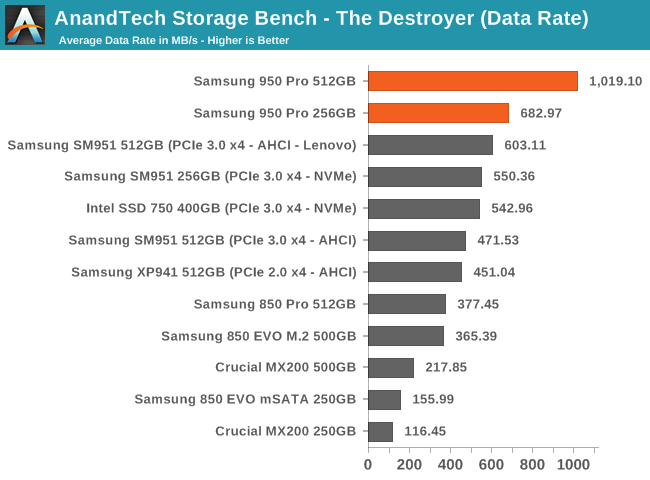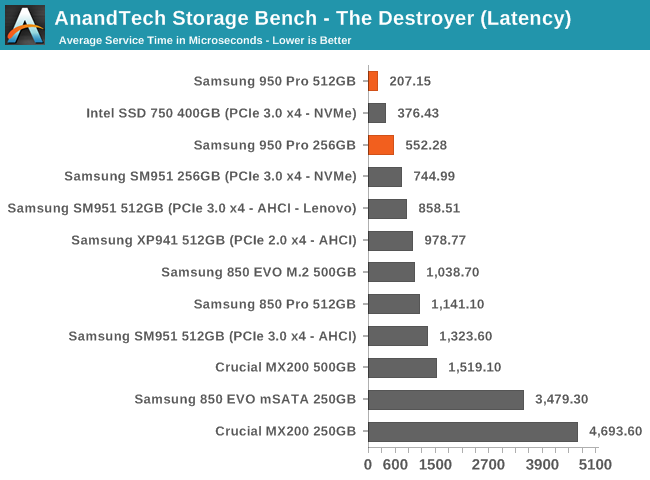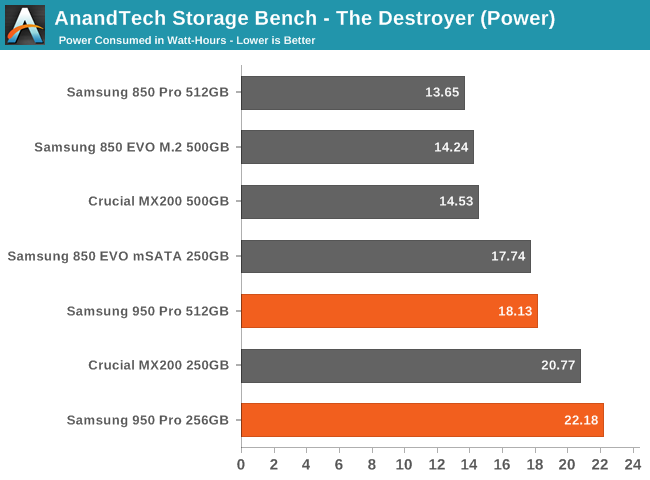The Samsung 950 Pro PCIe SSD Review (256GB and 512GB)
by Billy Tallis on October 22, 2015 10:55 AM ESTAnandTech Storage Bench - The Destroyer
The Destroyer is an extremely long test replicating the access patterns of heavy desktop usage. A detailed breakdown can be found in this review. Like real-world usage and unlike our Iometer tests, the drives do get the occasional break that allows for some background garbage collection and flushing caches, but those idle times are limited to 25ms so that it doesn't take all week to run the test.
We quantify performance on this test by reporting the drive's average data throughput, a few data points about its latency, and the total energy used by the drive over the course of the test.

Both 950 Pros deliver great performance on the destroyer, but the 512GB is outstanding. Clearly the more bursty nature of this test allows the drive to avoid any thermal throttling and deliver the high peak speeds that the PCIe interface is supposed to enable.

The NVMe drives deliver the lowest average service times, but the other PCIe drives are close behind. If there were any moments of thermal throttling like we saw with the performance consistency test, they would greatly inflate the average service time.

The very small number of performance outliers on this test is a good indicator that these drives don't sieze up under the pressure of an interactive workload.

When looking at the more strict latency threshold of 10ms, the 256GB 950 Pro is not significantly better than the good SATA drives, but the 512GB has extremely good control over latency.

Energy usage is not competitive with the high-performance SATA drives. As demanding as it is, The Destroyer still has opportunities for drives to scale back power consumption but the 950 Pro can't do that on our testbed.










142 Comments
View All Comments
AnnonymousCoward - Thursday, October 22, 2015 - link
This 5,600-word review utterly fails to penetrate to the bottom-line answer: the 950 Pro gives virtually zero desktop-usage performance advantage, while costing more than double of SATAIII drives. That only took 17 words.http://techreport.com/review/29221/samsung-950-pro...
Redstorm - Thursday, October 22, 2015 - link
Quote: "Lucky for that Samsung 950 Pro SSD or i would never have made that head shot" - said no one ever.PVG - Thursday, October 22, 2015 - link
I don't want to believe you tested a PCIe 3.0 4x drive on a board with a PCIe 2.0 x2 M.2 socket, so I'm guessing you used some kind of PCIe card adapter hooked up to the 3.0 lanes from de CPU, right?Billy Tallis - Friday, October 23, 2015 - link
Yep. We're always using the PCIe lanes off the CPU, and with a riser card and adapter that allows for the power measurement.PVG - Saturday, October 24, 2015 - link
That sounds like a cool setup. You should show it, sometime. ;)zodiacfml - Friday, October 23, 2015 - link
I'm just impressed with the SM951. All these PCIe drives are not terrible and gives excellent performance over SATA anyway. Their differences are pretty negligible in real world use. The challenge now (esp. for Samsung) is more capacity and lower prices.I can't shake the idea of NAS devices with M.2 drives.
zodiacfml - Friday, October 23, 2015 - link
Additionally, NVMe doesn't improve much for the clients. It seems like a specification they added on consumer drives to increase its adoption to benefit their server/enterprise storage products.wyewye - Friday, October 23, 2015 - link
Billy, you shit the bed: half of graphs are randomly missing Intel 750, the only competing consumer drive.However, good job on highlighting the termal issues of 950 Pro.
lilmoe - Saturday, October 24, 2015 - link
Welcome to the world of amazingly consistent charts, brought to you by Anandtech.SyukriLajin - Friday, October 23, 2015 - link
who knew that storage would require bandwidth as high as a graphic card. just a few years ago, it's the slowest component of your computer.